|
|
 |
Fiche d'espèce de Copépode |
|
|
Calanoida ( Ordre ) |
|
|
|
Arietelloidea ( Superfamille ) |
|
|
|
Heterorhabdidae ( Famille ) |
|
|
|
Mesorhabdus ( Genre ) |
|
|
| |
Mesorhabdus angustus Sars, 1907 (F,M) | |
| | | | | | | Ref.: | | | Sars, 1907 a (p.19); 1925 (p.236, figs.F); Sars, 1925 (p.236, figs.F); Sewell, 1932 (p.308); Rose, 1933 a (p.207, figs.F); Sewell,1947 (p.182, Redescr.F,M, figs.M); Moore, 1949 (p.57); S. Ali-Khan, 1993 (p.123, figs.M); Bradford-Grieve & al., 1999 (p.883, 943, figs.F); Park, 2000 (p.26, figs.F,M, Rem.) | 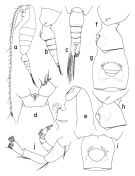 issued from : T. Park in Bull. Scripps Inst. Oceanogr. Univ. California, San Diego, 2000, 31. [p.159, Fig.7]. Female: a, habitus (left side); b, c, urosome (left, dorsal, respectively); d, e, forehead (ventral, left, respectively); f, g, genital somite with operculum open (left); h, i, genital somite with operculum closed (left, ventral); j, left A2 (posterior).
|
 issued from : T. Park in Bull. Scripps Inst. Oceanogr. Univ. California, San Diego, 2000, 31. [p.160, Fig.8]. Female: a, left Md (posterior); b, masticatory edge of left Md (posterior); c, masticatory edge of right md (posterior); d, left Mx1 (posterior); e, first inner lobe of left mx1 of a specimen from central north Pacific (posterior); f, left Mx2 (posterior); g, right Mxp (anterior); h, P1 (anterior); i, basipod of P1 (posterior); j, P2 (anterior); k, P3 (anterior).
|
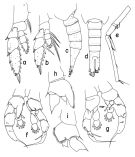 issued from : T. Park in Bull. Scripps Inst. Oceanogr. Univ. California, San Diego, 2000, 31. [p.161, Fig.9]. Female: a, P4 (anterior); b, P5 (anterior). Male: c, d, urosome (left, dorsal, respectively); e, segments 17-21 of left A1 (ventral); f, g, P5 (anterior, posterior); h, basipod of right P5 (anterior); i, basipod of left P5 (anterior). mpr = medial projection.
|
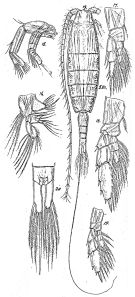 Issued from : G.O. Sars in Résult. Camp. Scient. Prince Albert I, 69, pls.1-127 (1924). [Pl.LXVI, figs.14-20]. Female (from near Azores Islands & off Brittany): 14, habitus (dorsal); 15, A2; 16, Mx1; 17, P1; 18, P3; 19, P5; 20, anal segment and caudal rami.
|
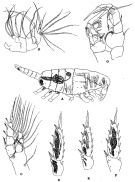 issued from : R.B.S. Sewell in The John Murray Expedition, 1933-34, Scientific Reports, VIII (1), 1947. [p.184, Fig.47]. Male (from G. of Oman): A, habitus (right dorso-lateral); B, Mx2; C, P1; D, exopoodal segments 2 and 3 of P2; E; exopodal segments 2 and 3 of P3; F, exiopdal segments 2 and 3 of P4; G, P5. Nota: The proportional lengths of the cephalothorax and abdomen as 66 to 34. The proportional lengths of the various segments of the body (cephalon to caudal rami) as 356:94:67:62:84:44:52:57:50:50:84 = 1000. Left A1 modified into a grasping organ. The A2 and mouth-parts resemble those of the female.
|
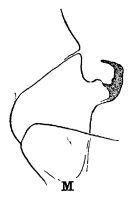 issued from : R.B.S. Sewell in The John Murray Expedition, 1933-34, Scientific Reports, VIII (1), 1947. [p.166, Fig.44, M]. Process on the posterior aspect of the 2nd basal segment of P1. Remarks: The shape of the hook-like or spine-like process shows some variation in different genera, but it is undoubtedly homologous throughout the whole series. The function of this organ is unknown. Nota female: The proportional lengths of the cephalothorax and abdomen as 65 to 35. The proportional lengths of the various segments of the body (cephalon to caudal rami) as 339:97:68:63:82:102:54:45:57:93 = 1000. The base of the rostral papilla is produced in a low rounded prominence that bears 2 delicate filaments. A well-marked cervical groove runs across the dorsal aspect of the cephalon. 4th and th thoracic segments fused. Genital segment equal in length to the two following segments. Caudal rami unequal, and the 2nd seta on the left ramus is much thickened, being about twice the length of the whole animal. The angle of the posterior thoracic margin is accupied by a compact mass of highly refractile gland cells that open on the external surface by a number of orifices. A number of dermal glands are scattered over the dorsal and lateral aspects of the segments of both regions of the body, and a small but compact gland is situated in the base of each caudal ramus. A similar gland is present in the proximal part of the 1st basal segment of P2 to P4. A1 (25-segmented) over-reaches the tip of the caudal rami by the last 6 segments. In A2 the 1st basal segment is produced in a rounded lobe at its posterior and inner angle; exopod reaches only about half-way along the 1st segment of the endopod. In Mx1 the various lobes bear the following number of setae: inner lobe 1 (10 delicate setae and 1 strong spine), inner lobe 2 (1 seta), inner lobe 3 (2); basal segment 2 (2); endopod (5); exopod (5 small and 6 large setae); outer lobe (6 large setae, the most posterior somewhat smaller than the other 5, and 3 small setae). In Mx2 the 3rd and 4th lobes each bear only 2 setae, whereas Sars figures 3 setae in both brevicaudatus and gracilis. In P1 the 2nd basal segment carries a stout flagellum-like process near the outer distal angle. The 2 nd and 3 rd exopodal segments of P2 to P4 are crowded with glands, that open by numerous pores, a gland is present in the 1 st basal segment of these legs.
|
 issued from : S. Ali-Khan in Crustaceana, 1993, 65 (1). [p;124, Figs.14-19]. Male (from 24°09'N, 64°27'E): 14, habitus (dorsal); 15, anal somite and caudal rami (dorsal); 16, A2; 17, Md (mandibular palp); 18, left Md (biting edge); 19, right Md (biting edge).
|
 issued from : S. Ali-Khan in Crustaceana, 1993, 65 (1). [p;125, Figs.20-24]. Male: 20, Mx1; 21, Mx2; 22, Mxp; 23, P2; 24, P5. Nota: These specimens agree with Sewell (1947) except for the 5th lobe of Mx2 that in the present specimens bears 3 setae while Sewell illustrated 2.
|
 Mesorhabdus angustus Mesorhabdus angustus female: 1 - Genital somite with spinules along posterior margin (Fig.7-f); oral cone with high anterior labral lobe (Fig.7-e); coxa of Mxp with 1+2+3 setae (Fig.8-g).
|
 Mesorhabdus angustus Mesorhabdus angustus male: 1 - In right P5, 2nd exopodal segment with medial projection at proximal end of segment (Fig.9-g).
| | | | | Ref. compl.: | | | Sewell, 1948 (p.330, 504, 527, 534, 538); De Decker & Mombeck, 1964 (p.13); Kazmi, 2004 (p.228) | | | | NZ: | 11 | | |
|
Carte de distribution de Mesorhabdus angustus par zones géographiques
|
| | | | | | | | | | Loc: | | | South Africa (E), Atlant. (S tropical), Bermuda, Sargasso Sea, Azores, off Bretagne, G. of Oman, N Arabian Sea, Laccadive Is., Philippines, China Seas (South China Sea), Okhotsk Sea (in C.B. Wilson, 1950, p.263), W Central America, Pacif. (tropical), off Solomon Is., Coral Sea, off Phoenix Is., off California | | | | N: | 9 | | | | Lg.: | | | (1) F: 5,8; M: 6,717; (11) F: 7,25; (403) M: 6,9-6,6; (824) F: 8,75-6; M: 8,5-6,75; {F: 5,80-8,75; M: 6,60-8,50} | | | | Rem.: | bathypélagique.
La localisation donnée par Wilson dans le Pacifique NW nécessite une confirmation. | | | Dernière mise à jour : 07/12/2020 | |
|
|
 Toute utilisation de ce site pour une publication sera mentionnée avec la référence suivante : Toute utilisation de ce site pour une publication sera mentionnée avec la référence suivante :
Razouls C., Desreumaux N., Kouwenberg J. et de Bovée F., 2005-2025. - Biodiversité des Copépodes planctoniques marins (morphologie, répartition géographique et données biologiques). Sorbonne Université, CNRS. Disponible sur http://copepodes.obs-banyuls.fr [Accédé le 21 octobre 2025] © copyright 2005-2025 Sorbonne Université, CNRS
|
|
 |
 |











